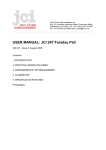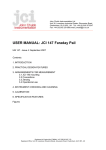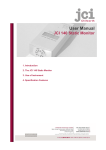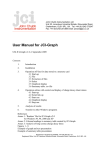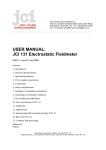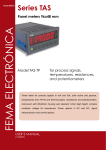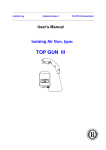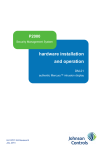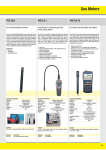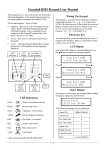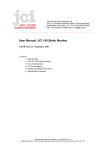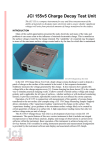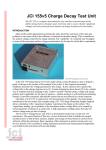Download USER MANUAL: JCI 134 Base Unit for JCI 131
Transcript
OOO OOO OOOOO OOOOO OOOOO OOOOOOOOOO OOO OOOO OOOO OOO OOOO OOO OOOO OOOO OOO OOOOOOOOOO OOO OOO OOOOOO OOO OOO OOOO OOO OOO OOOOOO OOOOOO OOO OOO OOO OOOOOOO OOOOOOO John Chubb Instrumentation Unit 30, Lansdown Industrial Estate, Gloucester Road, Cheltenham, GL51 8PL, UK. Tel: +44 (0)1242 573347 Fax: +44 (0)1242 251388 email: [email protected] ________________________________________________________________________________________ USER MANUAL: JCI 134 Base Unit for JCI 131 Electrostatic Fieldmeter UM134 - Issue 1: July, 2004 Contents: 1. Introduction 2. JCI 134 Specification features 3. Operational features 3.1 Basic features 3.2 Sensitivity range selection 3.3 Operational health facilities 4. Power supply requirements 5. Connections 6. Setting up 6.1 Basic set-up 6.2 Setting operatioanl facilities 6.3 Setting ambient field sensitivity 7. Operational health nonityoring 8. Safety and protection 9. Operation in flammable atmospheres 10. Operating environmental conditions 11. Applications 12. Data recording and processing References Figures CE CONFORMANCE John Chubb, proprietor of John Chubb Instrumentation of Unit 30, Lansdown Industrial Estate, Gloucester Road, Cheltenham, GL5l 8PL, declares as designer and manufacturer, that the JCI 131 electrostatic fieldmeter conforms to the requirements of the EC Directive on Electromagnetic Compatibility (EMC) 89/33/EEC to Standards EN 50081-1:1992 and EN 50082-1:1992. This instrument also conforms to the requirements of the Electrical Equipment (Safety) Regulations 1994 (SDI. 1994/3260), Signed for and on behalf of JCI: John Chubb Page - 1 USER MANUAL: JCI 134 Base Unit providing mains or battery operation of JCI 131 fieldmeters with display of fieldmeter reading and indication of operational health status. 1. INTRODUCTION JCI 131 fieldmeters may be operated in conjunction with a JCI 134 Base Unit to provide mains or battery operation and display of electric field measurements and indication of operational health status. The JCI 131 fieldmeter sensing head unit is shown in Figures 2 and 3. The JCI 134 provides opportunity to use both a mains input power supply with a battery connected at the same time for uninterruptible operation in the event of mains supply failure. Connections are provided for two battery inputs so that recharged batteries can be connected without interrupting operation. Power supply to the JCI 131 is 24V supplied as +12V and 12V. This supply voltage helps minimise resistive losses in the connecting cable. Operational power is switched on with a key switch. This provides protection against accidental interruption of operation. The fieldmeter output signal is proportional to the observed electric field. Signal output is 2.0V for electric fields at the sensing aperture of 2, 20, 200 or 2000kV m-1. Fieldmeter readings are displayed on a 3½ digit LCD on the JCI 134 as kV m-1. When used for atmospheric electric field observations or as part of a Lightning Warning System [1] the JCI 131 is likely to be mounted at the top of a pole (for example as shown in Figure 4) – for example a JCI 137. In this situation electric field values at the fieldmeter sensing aperture are enhanced over the anbient atmospheric electric field value [2,3]. The JCI 134 Base Unit provides the facilities to display the ambient atmospheric electric field and, optionally, the electric field observed by the fieldmeter. The relationship between ambient and observed electric field values depends upon mounting arrangements and influence of ground profile and nearby structures. Provision is made to cover such variations by user adjustment of the relationship. 2. JCI 134 SPECIFICATION FEATURES: Power supply: - Universal mains power supply (40W). IEC input connector in backplate fused 3A. - external 12V battery supply via either of two 2.1mm d.c. input connectors. - 24V supply output to JCI 131 fieldmeter. Power supply on/off: Key lock operated main power supply on/off switch on back cover Controls: - 2 key switches to select auto-ranging (pressed together) or to select a range and to change ranges up and down. ‘Up’ key flashes if over-range. - key switch to display fieldmeter health source signal (100% nominal) - key switch to display operational output signal (100% nominal) - toggle key selection of operational health on/off - push switch in back cover to select fieldmeter electric field values as opposed to interpreted ambient atmospheric electric field - pot to adjust FM sensitivity for display as ambient atmospheric fields Page - 2 - pot for fieldmeter zero adjustment JCI 131 connection: 19w connector (Pattern 105 AB05 210014-19SN00) in end cover to take cable to JCI 131 fieldmeter Signal outputs: - 25w D type connector for direct connection to all input and output signals on 19w cable together with operational and alarm status signals. These may be linked to external signal display and datalogging system. Earthing: Earth bonding terminal Displays: - 3½ digit LCD presentation of electric field - key operated options to show levels of operational health signals. - LO BATT indication on LCD - LED indicator for mains operation - LED indicator for external battery operation - LED indicators for health of fieldmeter Mechanical: 220x170 65mm deep metal enclosure, 2kg. 3. OPERATIONAL FEATURES 3.1 Basic feastures The JCI 134 Base Unit is housed in a 220 x 170 x 65mm deep metal enclosure. Cable connection to the JCI 131 is made via the 19w connector at the top end cover. There is also there a 25w D type connector for diagnostic and data recording. The back end cover houses a fused IEC mains supply connector, two 2.1mm d.c. power connectors for 12V battery operation, a power supply ON/OFF switch and fuse and a number of adjustment facilities. Figure 1 shows the layout of the top panel of the JCI 134. The small LEDs along the lower edge of the top cover indicate power supplies actively available. A separate LED shows when the JCI 131 is powered on by clockwise rotation of the key operated power supply switch at the right hand end of the back cover. When the JCI 131 fieldmeter is operating the electric field readings will be shown on the LCD. This will be the value interpreted by the setting of the range and sensitivity controls in the back cover. The actual electric field observed by the fieldmeter may be shown at any time by pressing the push button in the bottom cover. This push button is used in conjunction with sensitivity controls to adjust the normally displayed reading to be that for the fieldmeter or the ambient atmospheric eletcric field value. The adjustement procedure is described in Section 6.3. 3.2 Sensitivity range selection The default arrangement is for the JCI 131 fieldmeter to operate in an autoranging mode. A step down of sensitivity is made at a signal level close to the full scale output of 2.0V, and a step up in sensitivity at an output level around 0.15V. If it is desired to access and hold a particular range then when a ‘Range control’ up or down key is pressed the range will be incremented or decremented a step. To return to the auto-range mode both keys are pressed together. 3.3 Operational health facilities Page - 3 If the operational health facility is fitted to the JCI 131 fieldmeter head unit [1] then LEDs on the top cover indicate the operastional health status. The operastional health may be toggled on and off using the key switch, and an LED indicates while the facility is activated. If the operational health drive signal and/or the observed health signal are below 90% of the values to be expected then the amber LEDs in the appropriate key switches are illuminated. If these LED keys are pressed at any time the LCD will show the percentage of satisfactory level for these two components. If the operational health facility is not fitted to the JCI 131 fieldmeter then none of the operational health control switches are active and none of the associated LEDs illuminate. 4. POWER SUPPLY REQUIREMENTS The JCI 131 fieldmeter can be operated from a power supply of 12-36V with a capability of about 1A capability. Running current is about 400mA at 12V. The wide range of supply input makes it easier to work with long cables and less well defined supply sources. With long cables the voltage drop along the lines needs to be noted and it will be wiser to expect to operate from a voltage source supply nearer to 36V rather than 12V. The regulated power supply voltages needed for instrument operation are created from a 9-36V input d.c./d.c. converter inside the fieldmeter head unit. 5. CONNECTIONS Power supply and signal connections between the JCI 134 Base Unit and the JCI 131 fieldmeter are made via sealed 19w Mil connectors. The following table lists both the connections at each 19w socket and the connections available via the 25w D type diagnostic connector. (Signal line identities are also listed for operation of an enhanced version Base Unit which, with the radio circuit board fitted into the fieldmeter, makes a JCI 503 Lightning Warning System. These lines are not connected in the JCI 134 Base Unit). Cable feature Cable sheath & case 0V +12V power -12V power Fieldmeter 0V Fieldmeter signal Range bit 0 (field x10) Range bit 1 (field x100) Zero adjust Field overrange Noise signal Noise x10 Health inhibit Field health drive Noise health Impulse signal Impulse x10 Impulse health Field health signal Field DVM 19w cable connector A green/yellow B black C red & yellow/blue D blue & blue/white E green F white G yellow H brown J violet K orange L pink M turquoise N grey P red/blue U green/red V yellow/red R white/red S red/black T red/brown Field range +1 Field range -1 25w D type diagnostic socket 1 2 3 4 5 6 7 8 9 10 11 12 13 14 15 16 17 18 19 20 21 Page - 4 Noise DVM (dB) Lightning pulse Amber lightning alert Red lightning alert 22 23 24 25 Fieldmeter operation will be satisfactory with cable lengths to at least 100m. The cable shielding braid should be earth bonded at both ends. For good quality analogue signal observations over long cable lengths it is wise to use a unity gain differential buffer amplifier between the fieldmeter 0V and signal lines at the signal processing end. The signals indicating and controlling the sensitivity range and external zero adjustment are relatve to instrument 0V - the black lead on connection B. Cable: DEF Stan 61-12 Part 4: 7/0.2 PVC insulated, overall braid screened, PVC sheathed type 7-2-20C. Resistance: 0.08 ohms per metre each core. Capacitance: 160pF per meter per conductor to sheath. Connectors: Sealed 19w cable connectors (Pattern 105). Free plug: AB05 602714-19PN00 Socket: AB05 210014-19SN00 6. SETTING UP 6.1 Basic set up Connect the cable from the JCI 131 sensing head to the 19w connector on the JCI 134 Base Unit. Connect either a mains power supply or a 12V battery (positive center connection) to either 2.1 d.c. power sockets in back cover. The appropriate LED at the bottom edge of the top cover should illuminate. Switch on using key-lock rotary switch at right hand side of back plate. The power on’ LED should illuminate amnd the LCD should show a reading. If the JCI 131 is connected it should start operting and if a piece of rubbed plastic is brought into the vicinity of the fieldmeter sensing aperture the LCD should show an appropriately increasing reading. For checking the zero reading of the fieldmeter a suitable Zero Check Chamber (for example a JCI 152) is placed over the sensing end of the fieldmeter. With the push button to select the direct fieldmeter reading depressed the zero setting potentiometer in the back cover is adjusted for a zero reading on the LCD. A reading within 1-2V m-1 should be achieved. 6.2 Setting operational facilities The basic sensitivity of the JCI 131 as a voltage probe is close to 10kV m-1 for a local potentila of 1kV. If this is mounted at the top of a, say, 2m pole then a reading of 10kV m-1 will correspond to an ambient local field of 0.5kV m-1 [4]. If the operational health shield is fitted that the fieldmeter readings will be about 50% of the aove figure – around 5kV m-1 for an ambient field of 0.5 kV m-1. The actual local voltage sensitivity of the fieldmeter sensor, at its mounted position, can be established (or checked) by operating the JCI 131 and JCI 134 isolated from ground and applying a calibration voltage to the assembly. With the ‘Check sensor electric field’ pressed (so the LCD shows directly the actual fieldmeter reading) apply a measured voltage between external earth and the earthing terminal of the JCI 134. Note the change in LCD reading between applying this voltage and earthing the assembly. The actual ambient atmospheric field corresponding to this voltage change is then simply the voltage change divided by the height of the pole in metres. 6.3 Setting ambient electric field sensitivity The ‘Check sensor electric field’ push button in the back cover provides opportunity to switch the LCD reading between fieldmeter readings and interpreted ambient electric field values. The local voltage sensitivity of the JCI 131 fieldmeter, and the operational health shield Page - 5 if fitted, are established as above. The interpreted value of ambient atmospheric electric field are obtained with knowledge of the pole height. The display may be adjusted to give appropriate values of ambient electric field using the potentiometer in the back plate. Matching between fieldmeter and ambient values is achieved using the ‘Check sensor electric field’ push button. If the JCI 131 needed to be mounted at a location where there may be some shielding of atmospheric electric fields by nearby structure or is mounted on a building then the absolute level of readings may be estanblished in clear blue sky conditions by comaping readings to ambient electric field values established at the same time with a pole mounted fieldmeter readings on a large flat area of ground. The clear blue sky ambient eletcric field will be about 100V m-1. A large flat area should give clearances of a few hundred metres to any trees or structures. 7. OPERATIONAL HEALTH MONITORING To give confidence in operational performance in long term continuous observations an operational health system has been developed for the JCI 131 fieldmeter. This is available as an optional extra facility. Operational health monitoring was originally developed as part of the JCI 501 Lightning Warning System [1]. In that system the whole fieldmeter sensing head unit was modulated with a low frequency square wave alternating signal of some 50V peak to peak amplitude. This modulated the observed electric field signal and the amplitude of modulation was compared to the level expected. The present facility involves mounting an additional shield around the casing of the JCI 131 fieldmeter sensing head, , and modulating the shield with a sinewave voltage at half the electric field modulation frequency. The body of the fieldmeter remains at earth potential. Separate phase sensitive detection enables the modulated signal from the shield to be selectively extracted for comparison to the level expected. There is no influence on normal ambient field measurements The voltage swing of the shield is set appropriate to the fieldmeter operating range of sensitivity, and may be up to 600V p-p for the low sensitivity range. The operational health status is displayed on the JCI 134 is two ways: first, the level of the operational drive signal (‘Health drive’) is compared to its target value (1.0V) and if it is less than 90% of this then the key amber LED is illuminated. Second, if the fieldmeter health signal is less than 90% of the drive signal then the ‘fieldmeter health’ key amber LED is illuminated. At any time either or these keys may be pressed and the LCD will then show the status of each of these operational heath signals as a % of expected value. If the operational healthe facility is not included in the JCI 131 then no LEDs will be illuminated when the ‘Health on/off’ key is pressed. Also when either the and the LCD will display only 0.0 when the ‘fieldneter health OK’ key is pressed. 8. SAFETY AND PROTECTION It is important to avoid any articles, or fingers, to enter the sensing aperture of the JCI 131 fieldmeter - particularly when the chopper assembly is rotating. It is aslo important not to drop or hit the fieldmeter sensing head unit as this could damage the alumina sleeve insulator that mounts the rotor assembly on the motor shaft. 9. OPERATION IN FLAMMABLE ATMOSPHERES The JCI 131 is not Certified as suitable for use in areas where flammable atmospheres are, or may be, present. 10. OPERATING ENVIRONMENTAL CONDITIONS Page - 6 No specific tests have been made to find the allowable operating environmental conditions. An operating range is suggested of 0-30C and 20-100%RH including direct rain precipitation into the sensing aperture. There is no reason why the JCI 131 will not operate satisfactorily below 0C purely in terms of ambient temperature If there is a prospect of snow or freezing rain or of sub-zero temperatures after snow precipitation then it is recommended that the Sensor Unit is kept in continuous operation, and so kept warm, to avoid clogging operation of the rotating chopper assembly. 11. APPLICATIONS Applications for the JCI 131 fieldmeter are described and discussed in the instrument user manual. 12. DATA RECORDING AND PROCESSING The 25w D tryope connector provides access to all fieldmeter and analysed signals – as idenbtified in Section 5 above. These signals may be displayed and or recorded according to user interests. One approach that may be useful for computer based data recording, which is Windows compatible (up to XP), is use of a Picoscope digital storage oscilloscope facility (www.picotech.com). REFERENCES [1] J. N. Chubb, J. Harbour “A system for the advance warning of the risk of lightning” Proc ESA Annual Meeting 2000. Brock University, Niagara Falls, Ontario June 18-21, 2000 [2] J. M. Van der Weerd "Electrostatic charge generation during washing of tanks with water sprays, II Measurements and interpretation" Static Electrification Conference, London, 1971 IoP p 158 [3] J. N. Chubb, G. J. Butterworth, "Instrumentation and techniques for monitoring and assessing electrostatic ignition hazards" Electrostatics 1979 Inst Phys Confr Series No 48 1979 p 85 [4] JCI Website: www.jci.co.uk (for example www.jci.co.uk/Measurements/AtmosEfield.html and www.jci.co.uk/Electrostatics/Wshop-00.html) Page - 7 Figure 1: Top cover layout for JCI 134 Base Unit Page - 8 Figure 2: General view of JCI 131 Electrostatic Fieldmeter Figure 3:Internal features of JCI 131 Page - 9 Figure 4: JCI 131 fieldmeter mounted for measurement of atmospheric electric fields Page - 10











